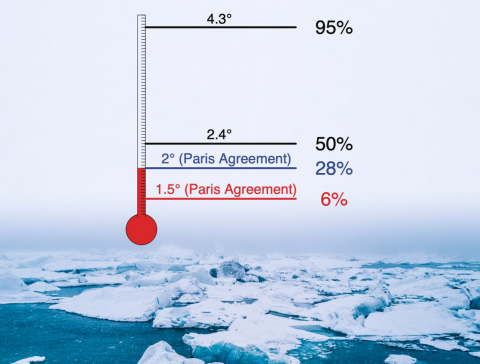Research published in this week’s issue of Nature Communications reveals a considerable chance for an ice-free Arctic Ocean at global warming limits stipulated in the Paris Agreement. Scientists from South Korea, Australia and the USA used results from climate models and a new statistical approach to calculate the likelihood for Arctic sea ice to disappear at different warming levels.
Future climate projections are usually obtained from global climate computer models. These models are based on several hundred thousand lines of computer code, developed to solve the physical equations of the atmosphere, ocean, sea-ice and other climate components. Applying future greenhouse gas concentrations, each computer model produces a version of what the future of the Earth’s climate might look like.
Transforming this information into practical decisions is not easy, because of the remaining uncertainties in the magnitude of future climate change on regional scales. Decision-making in a warming world requires an understanding of the probabilities of certain climatic events to occur.

yananfan-cropped.jpg
Assoc Prof Yanan Fan
"To solve this problem, the research team has developed a novel statistical method where the principles of Bayesian model averaging was extended to the case of dependent models. The team also developed a novel and efficient Markov chain Monte Carlo algorithm for the computation," said UNSW Associate Professor Yanan Fan, an Associate Investigator for ACEMS.
The statistical method ranks the models in terms of how well they agree with present-day observations and accounts also for inter-dependencies amongst the models.
“Translating model dependence into mathematical equations has been a long-standing issue in climate science. It is exciting to see that our method can provide a general framework to solve this problem,” said co-author Won Chang, assistant professor in the department of Mathematical Sciences at the University of Cincinnati, USA.

climate-graphic.png
Figure 1: Probabilities of Arctic summer sea ice disappearing when crossing certain global Probabilities of Arctic summer sea ice disappearing when crossing certain global levels. Figure credits: Elke Zeller and Roman Olson.
For a 2°C warming, the probability for losing the ice rises to at least 28%. Most likely we will see an ice-free summer Arctic Ocean for the first time at 2 to 2.5°C warming.
“Our work provides a new statistical and mathematical framework to calculate climate change and impact probabilities,” commented Jason Evans, professor at the Climate Change Research Centre in UNSW Australia in Sydney.
“Up to now, there was no established mathematical framework to assign probabilities on non-exclusive theories. While we only tested the new approach on climate models, we are eager to see if the technique can be applied to other fields, such as stock market predictions, plane accident investigations, or in medical research”, says Roman Olson, the lead author and researcher at the Institute for Basic Science, Centre for Climate Physics (ICCP) in South Korea.
The work resulted from a collaboration between the ICCP at Pusan National University and the IRCC at Yonsei University, South Korea. Other co-authors on this study are Soon-Il An, Professor of Atmospheric Sciences at Yonsei University, South Korea; and June-Yi Lee, Professor at Research Centre for Climate Sciences in Pusan National University, South Korea.
